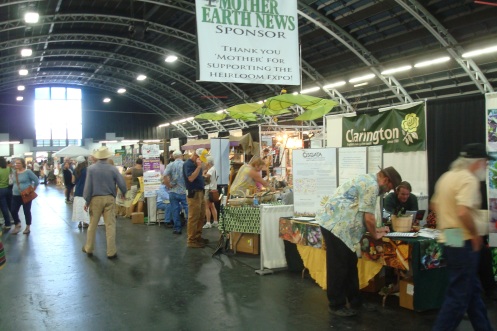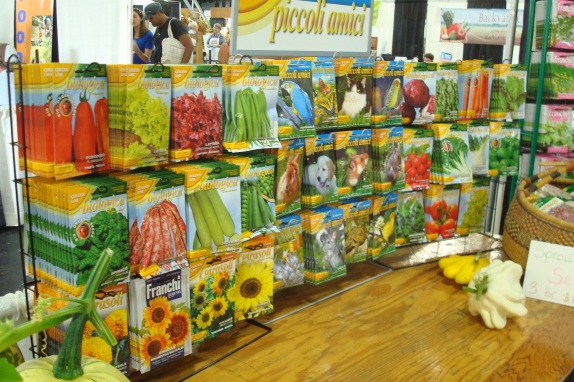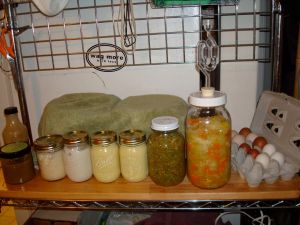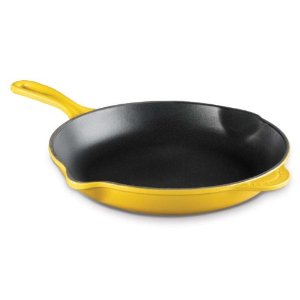Whew! We just spent a very full day at the 2nd Annual National Heirloom Exhibition in Santa Rosa, California, and wished we could spend the full three days. If there’s any way you can get there, go! There’s so much to do and see, it’s rather overwhelming, but in a good way. It’s not just beautiful, but educational and inspiring. It was also a great chance to do some networking. We ran into the owner of our favorite natural foods co-op back in Mendocino, and she learned we had eggs to sell, so I now have a retail outlet for my eggs. Yay! And that was the least of it.
We’re planning for the full 3 days next year, Gaia willing. Meanwhile, here are a few of my (less blurry) snapshots to whet your appetite.
Lots of wonderful garden displays by vendors filled the main hall, and outdoor exhibition space as well. My apologies for blurry photos; clearly I need to upgrade my camera as I can’t tell when it’s in focus. Or maybe I need to wear my glasses.
I loved the native plant displays. Lots of plants for sale, no money!
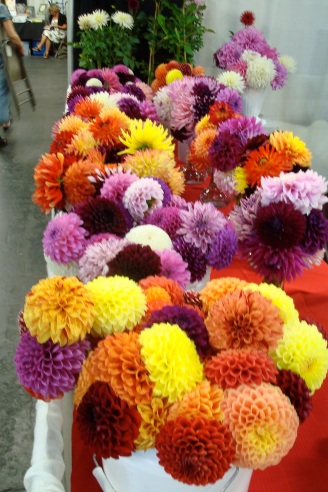 Indoors, there were also lovely plants: lots of seedlings and more. Love the zinnias!
Indoors, there were also lovely plants: lots of seedlings and more. Love the zinnias!
It was wonderful to see how many seed companies, seed banks, and seed saver organizations (seed libraries!) were represented. Thank goodness Monsanto hasn’t got ahold of all of them yet.
I was very inspired by the “botanical art” displays, which abounded at the exhibition, whether in the vendor hall, the produce exhibition hall, or outdoors.
A couple of recent incidents have got me pondering the question, who is in charge of your health? Kelly the Kitchen Kop has revisited a very upsetting case about the medical system forcing children to have chemotherapy, even, as in this case, when the child is cancer-free: Update on the Stieler Case – Creating a Dangerous Law Where Doctors Are Always Right.
Are doctors always right? Obviously not. It’s a logical fallacy to assert that someone’s research or opinion or position on a particular topic is correct simply because they have certain credentials. And too many of us have learned to automatically trust and respect anyone wearing a lab coat and an “M.D.” name tag without taking responsibility for our own health decisions. I am not hostile to medicine, but I don’t trust doctors that haven’t learned anything post-medical school about nutrition, aside from the USDA food pyramid (or, currently, “My Plate“). Food is not just fuel, it is meant to provide the essential raw materials our bodies need to function. If our food doesn’t provide the elements needed, including tiny amounts of various micronutrients, we are set up for eventual dysfunction and disease.
Here’s a completely different, albeit no less dramatic, situation that I became aware of this week.
A coworker, whom I’m guessing is in his 60s, told me this story about his wife, who is suffering from memory problems, possibly early dementia. The previous day, she had told him that someone, she has no idea who, called their house, and she, the wife, gave this unknown person her full name, address, birthdate, social security number, bank account number, and credit card numbers. Thank goodness she remembered she had done this and told her husband, who spent the evening making no doubt frantic phone calls to the bank and credit card companies. Next week he’ll be taking time off work to drive an hour and a half to the nearest Social Security Administration office to present various documentation proving they are who they say they are. Horrifying, right? Read more…
 I’ve spent the past week avidly reading, and sometimes joining in, a vigorous debate in response to The Top 10 Reasons I’m Not Paleo. The author apparently felt it necessary to defend her choice to eat croissants, cheese, and sprouted grain products (as part of a well-rounded, nutrient-dense diet). We are all, of course, free to eat as we choose, and I’m not the food police. I only object to the misrepresentation of the paleo/primal/ancestral health movement, which has much to teach us about healthful living.
I’ve spent the past week avidly reading, and sometimes joining in, a vigorous debate in response to The Top 10 Reasons I’m Not Paleo. The author apparently felt it necessary to defend her choice to eat croissants, cheese, and sprouted grain products (as part of a well-rounded, nutrient-dense diet). We are all, of course, free to eat as we choose, and I’m not the food police. I only object to the misrepresentation of the paleo/primal/ancestral health movement, which has much to teach us about healthful living.
I don’t label myself as “paleo.” I’m just a Real Food lover who struggles to put what I have learned into practice. Several paleo/primal living gurus such as Robb Wolf, Mark Sisson, Chris Kresser and others have certainly influenced me on my food and health journey — and none more than the late, great nutrition researcher Weston A. Price and his chief evangelist, Sally Fallon Morrell of the Weston A. Price Foundation.
Some of the following points are quotations from the post, and some are my extrapolations. Read more…
I splurged a few days ago and ordered three new books on one of my favorite topics: the magic of lacto-fermentation, the process by which we preserve foods and “make them more digestible and more nutritious,” according to Nourishing Traditions author Sally Fallon. These are not by any means the first pickling books to find a home on my crowded bookshelves. Learning how friendly microbes transform ordinary vegetables and fruits (and more) into delicious new forms, and how those cultured foods can restore digestive health, is exhilarating.
For me, it all started with Wild Fermentation: The Flavor, Nutrition and Craft of Live-Culture Foods, which I suppose makes me a sort of early adopter. I feel like author Sandor Katz personally introduced me to sauerkraut because, well, he did. Almost 9 years ago, I was shopping at the venerable Rainbow Grocery food cooperative in San Francisco, when an announcement over the public address system informed one and all that someone was about to start an in-store demonstration of the art of making sauerkraut. I’d never liked sauerkraut growing up, because I was only exposed to the canned version, which is a pointless travesty. Yet I had recently become interested in the topic, having just bought Nourishing Traditions and entertained the idea of culturing vegetables. So I made a beeline over to the little corner of the store where a few folding chairs were set up and I grabbed one on the front row and avidly watched Katz chop and pound and squeeze a mountain of cabbage practically in my lap. Entranced by Katz’s practiced patter, and seeing that Fallon had written the foreword to the book, I bought a copy of Wild Fermentation and read it pretty much straight through, not something I ordinarily do with a cookbook. Read more…
One of my favorite memories is my trip to the Netherlands way back before I went to graduate school. So that must have been… let’s see… about 1988? Goodness gracious. Anyway, one of my favorite outings was to Keukenhof, the flower capital of the world (I just named it so), in the town of Lisse. It’s a lovely park planted with millions of flowering bulbs in enormous beds flanked by sweeping green lawns and scattered trees. It is just breathtaking. And I didn’t even see it at the peak.
A blogger I follow, Malou Prestado, a Filipina who is married to a Dutchman, takes wonderful photos of her adopted country. Here are her Keukenhof photos, taken right at the peak of tulip season.
Holland’s spring garden in April 2011 « Going Dutch.
Meanwhile, I’ve been tending chickens, and chicks (seven chicks!), and goats, and working two jobs, so not much blogging. I think about it a lot, and I will be back. Enjoy the show!
I downloaded my recent chicken photos and put up a basic webpage with the photos of the roosters. A new chicken-keeping contact on the other side of town said she is interested in one of them, Mr. Big, a Barred Plymouth Rock, for a breeding project. Check out the first installment of The Chickens of Kind Food Farm. Read more…
Hooray! It’s Day 1 of the Kettlebell Challenge! I’m so excited that so many of you have decided to join me.
If you have no idea what I’m talking about, click here to visit the Kettlebell Challenge page and learn all about it.
From Kettlebell Challenge: Welcome to Day 1 | CHEESESLAVE.
Kettlebells really are a fun workout, and very effective. You can do it with a DVD or without, out on your deck with a view, or inside where it’s warm. Muscles are sexy! Everyone who signs up referred by me, let me know, you’ll earn me 25 more points in the kettlebell challenge! It costs you nothing to sign up, except, of course, the cost of a kettlebell.
You can buy used ones, like I did, at Play It Again Sports in Santa Rosa, CA. I’m not sure where else they are, but there must be other sources of used kettlebells. Amazon.com sells kettlebells, and some are even eligible for free shipping via Amazon Prime. WalMart has them in store and online, and most sporting goods stores should have them now. Women should generally start with 15-15 pounders, men with 20-25 pounders, for traditional kettlebell moves. I bought 3 different weights on a rare trip down to Sonoma County, because I figured that eventually, between me and David, we’d use all the weights. Read more…
Here’s another fun giveaway from one of my Real Food pals, Kelly the Kitchen Kop. Who couldn’t use a Le Creuset cast-iron skillet?
$100 Prize Giveaway: Le Creuset Cast Iron Skillet! (Plus Scoop on Safe Cookware).
Our study has some limitations. First, as a meta-analysis of observational studies, we cannot rule out that individual studies may have failed to control for potential confounders, which may introduce bias in an unpredictable direction. All studies controlled for age and smoking, but only a few studies adjusted for other potential confounders such as body mass index and history of diabetes. Another limitation is that our findings were likely to be affected by imprecise measurement of red and processed meat consumption and potential confounders.
Let me put that into plain English: Our findings are meaningless. The studies we analyzed were based on food-recall surveys that are notoriously inaccurate, and most of them didn’t control for body mass index or diabetes, which essentially means they didn’t control for intake of sugars and refined carbohydrates.
So says Tom Naughton in his recent blogpost: Fat Head » Pancreatic Cancer, Processed Meat, and a Load of Bologna. I love Tom! If you haven’t seen his documentary, “Fat Head,” get it from Netflix now!
DrCate.com, otherwise known as Catherine Shanahan, M.D., author of Deep Nutrition, discusses pro-dairy and anti-dairy arguments within the Paleo community in the linked post. In my short four days of Paleo thus far, my skin was clearing up until today, when I ran out of time for a proper breakfast and made a protein shake with whey protein, coconut milk, cream, and frozen strawberries.
Oh, and fresh egg yolks, of course. Read more…


